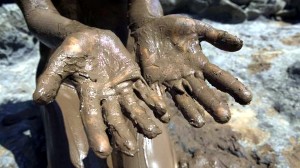In my last post, I discussed creativity in terms of the theories of play promoted by Dr. Stuart Brown. If his TED talk “hit” numbers mean anything, I’m not the only one with whom his thinking has resonated.
Reviewing my own lifetime’s moments of enjoyment and creativity, I noted the recurrence of certain types of play and play media. I was pleased when my Champlain College students independently affirmed similar themes.
We wrote brief “play histories” that described our favorite pastimes as children, the level to which our parents gave us liberty to take risks, the amount of time we spent just goofing around as opposed to structured activities such as sports or lessons, and the level of enjoyment we associated with those activities.
Without exception, my students’ best memories were of the unstructured playtimes, when they and friends — or, importantly, on their own — invented the universe on the fly. They made up high-drama stories and took roles in them, used any objects at hand as props, invented rules, adapted those rules as needed, and experimented with diverse identities as bad guys, good guys, princesses, kings, warriors, monsters, bunnies.
Another point emerged that supports Dr. Brown’s theories. He emphasizes the importance of the hand in play: quoting a colleague, he describes us as “a brain in search of a hand, a hand in search of a brain.” “Play,” he says, “is the medium by which those two are linked.”
My own observations as a father reinforce that contention: I watched each of my three children — babies in the crib — as they learned that they could control external phenomena. That is, lying on their backs, they discovered that those objects most directly in their field of vision — hands — seemed to respond to intention, to a volitional impulse. Magic!
Before long, they relied on these responsive tools to do their bidding and start affecting the world of material things. Their hands provided tactile information, permitted assessments of spatial distance, and served as manipulators of non-self physical objects.
The visual images of their own hands, fluttering and flailing above their faces, correlated with their proprioceptive sense (internal awareness of where parts of the body are spatially located). Their hands helped them understand that they had bodies, and bodies had different parts, and that those hand parts were functional tools that could effect changes in other phenomena.
Dr. Brown refers to the importance of hand-playing in advanced creative thinking. The U.S. Jet Propulsion Laboratory (JPL) identified certain weaknesses among their stable of bright minds, particularly in the area of problem solving. They eventually accepted the claims of neurologist Frank Wilson and high school mechanics teacher Nate Johnson that prior experience manipulating machines, working on mechanical objects and assemblies with their hands, encouraged greater problem-solving ability (e.i. innovative yet pragmatic thinking) than theoretical knowledge alone.
Those principles have been adopted by JPL, NASA, and Boeing in their recruitment practices. And this comes as no surprise to my students, who went on to identify some other elements common to the best play experiences.
One was mud. What better, more versatile toy is there? “Malleable media” such as mud, dirt, sand, Silly Putty, chewing gum, water, and clay are responsive to the hand and lend themselves to endless engineering and artistic experiments. No specialty tools or prior training required.

Sigmund Freud. Try to find a photo of him smiling! Was he play-deprived? Photo thanks to www.biography.com
Mud can shape animals or people, can be used to paint pictures or faces, can be thrown as a non-lethal weapon, can be heaped into forts, and much more. Freud believed mud and paint served subconsciously as surrogate feces– but, in fact,who has ever played with poop? What animal in the wild? Freud should have seen a shrink to figure out where this idea originated!
Malleable media are fun, allow hand and imagination to make the player a god capable of shaping anything. The Biblical God was playing with mud, I’m given to understand, when He [sic] created Adam.
But malleable media, we then discovered, belong to an even larger play-tool category, that of non-specific or “variable function” objects or media.
The universal, ubiquitous stick is the best example. In play, it can serve as a walking stick, a magic wand, a spear, a bow, an arrow, a rifle, a sword, a lever, a pretend person, a target to throw rocks at, a part of a fort, a snake, a prop for circus tricks, a flag-staff, a cane or crutch when you’re pretending to be old or injured, a baseball bat, a hockey stick. No single-function manufactured toy rivals this versatility.
You would find it quite cumbersome and inconvenient to set out to play carrying a toy spear, bow, arrow, rifle, sword, board, bat, crow-bar, snake, cane, balancing pole, and flag-staff. But find the right stick and you’re all set.
So: The hand. Malleable media. The non-specific object.
They are all key components of the ability to generate, innovate, imagine — and to become an actor, an agent of change, in the world. They affirm personal empowerment, which is the first and most important of all creative assumptions. Mud proves to us that the world is indeed responsive to our efforts to affect it (the world). Sticks demonstrate that we can assign diverse functions to features of the physical and conceptual world, and can make of them what we will.
These realizations are the very root of creativity.
And playing with them helps our developing brains grow into highly-functional configurations and develop healthy neurochemistry. They “potentiate” neural pathways, can actually assist expression of genes that lead to an optimally-performing organism, and, later in life, can re-invigorate atrophying neural networks.
Plus, they’re fun.
But play is important not just in terms of fun or creative achievement, but in terms of psychological health, wholeness, and social integration. I’ll consider Dr. Brown’s thoughts about risk and mass murder in the next post.
Links: www.preschool-plan-it,com , english.people.com.cn , g2goutside.org , www.biography.com , danielhecht.com




